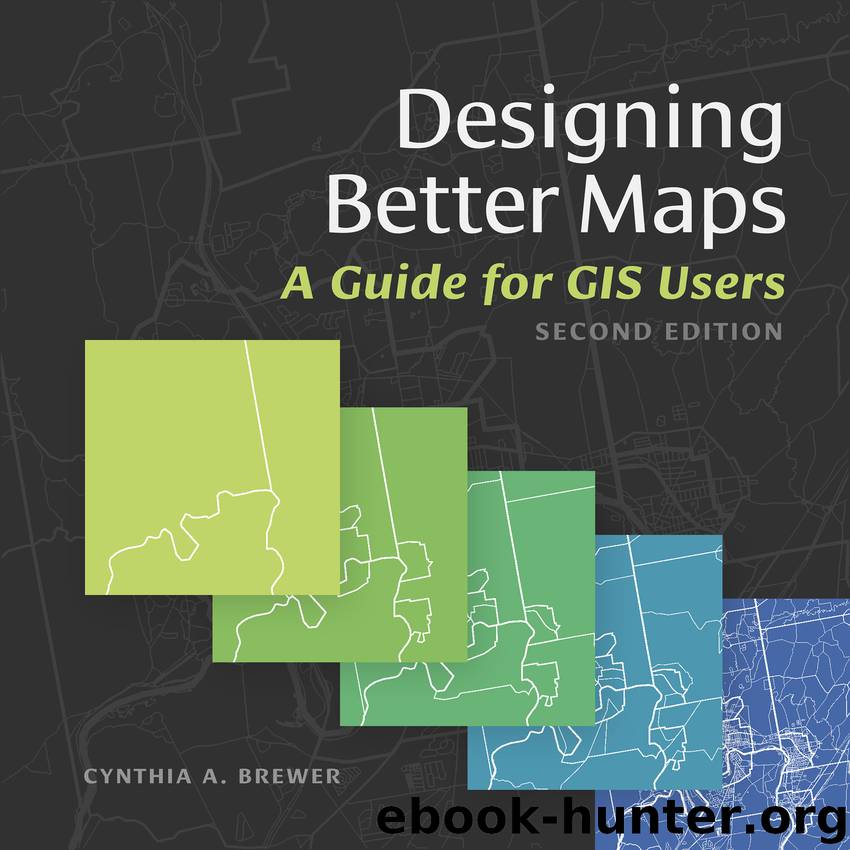Designing Better Maps by Brewer Cynthia A

Author:Brewer, Cynthia A.
Language: eng
Format: epub
Publisher: Lightning Source Inc.
Published: 2016-02-27T16:00:00+00:00
Figure 5.17 The Wingdings character map with a mouse icon selected.
Font formats and permissions
Fonts are technically miniature programs, installed within the operating system as a set of files. These files contain instructions to be used by the operating system and other software that display the fonts correctly. Remember, each letter in a font is a set of precisely set lines and curves. Font files include these geometric specifications as well as tables that determine how far apart the letters should be spaced when placed next to each other. The most common types of fonts used for graphic products are OpenType (O icons), TrueType (TT icons), and PostScript (red a icons). WOFF (Web Open Font Format) and EOT Lite (Embedded OpenType Lite) are used to show fonts on web pages.
Your computer probably has about one hundred typefaces pre-installed, and many applications install more fonts as the software is installed. These typefaces will probably be sufficient for your needs, but if you want to look further afield, beware of the glut of “free” fonts on the Internet. Many of these are poorly designed and do not contain the full character sets or enough additional styles (such as bold and italic) that you will need when you make maps. Be critical of the source of your fonts. Fonts are commercial products that vary in their quality of completeness and precision of the drawings of letterforms. Cheap fonts may be poor copies of the original finely drawn characters. There are many free and open-source fonts, however, that are created by reputable designers. Websites that offer these typefaces include Font Squirrel (http://www.fontsquirrel.com) and FontShop (http://www.fontshop.com/people/fontshop-team/fontlists/free-fonts).
It may seem like fonts that were installed by default on a computer are free. Although they were included in the purchase price of the computer and various software packages, you should know that, unless explicitly noted, fonts are intellectual property that are licensed when purchased. To legally produce a map with a customized design, you may need to purchase a font. If you give font files to other people so that they can see your design with the intended fonts, you may be breaking the license agreement you made when you or someone else purchased the font.
When you open a map file but do not have all the fonts used on the map, software will often prompt you to substitute another font. Font substitution may disrupt the look and fit of labels and symbols, length and spacing of text lines, and other design aspects that were carefully set within the map based on characteristics of the original fonts. Rather than redistribute the font files, which may be against the license agreement, one map design strategy is to use open-source typefaces that are distributed under the SIL Open Font License. This license allows the user to freely download, install, and redistribute the typefaces, even in commercial, for-profit products. Published or sold work may need to credit the font designer. Another option for preserving fonts is to choose an export option that can be set to embed fonts in the file (making the file size larger), such as PDF.
Download
This site does not store any files on its server. We only index and link to content provided by other sites. Please contact the content providers to delete copyright contents if any and email us, we'll remove relevant links or contents immediately.
| Historic | Information Systems |
| Regional |
Man-made Catastrophes and Risk Information Concealment by Dmitry Chernov & Didier Sornette(4734)
The Revenge of Geography: What the Map Tells Us About Coming Conflicts and the Battle Against Fate by Kaplan Robert D(3597)
Zero Waste Home by Bea Johnson(3288)
COSMOS by Carl Sagan(2950)
In a Sunburned Country by Bill Bryson(2945)
Good by S. Walden(2912)
The Fate of Rome: Climate, Disease, and the End of an Empire (The Princeton History of the Ancient World) by Kyle Harper(2434)
Camino Island by John Grisham(2383)
A Wilder Time by William E. Glassley(2362)
Organic Mushroom Farming and Mycoremediation by Tradd Cotter(2306)
Human Dynamics Research in Smart and Connected Communities by Shih-Lung Shaw & Daniel Sui(2177)
The Ogre by Doug Scott(2114)
Energy Myths and Realities by Vaclav Smil(2059)
The Traveler's Gift by Andy Andrews(2010)
Inside the Middle East by Avi Melamed(1939)
Birds of New Guinea by Pratt Thane K.; Beehler Bruce M.; Anderton John C(1906)
Ultimate Navigation Manual by Lyle Brotherton(1767)
A History of Warfare by John Keegan(1713)
And the Band Played On by Randy Shilts(1615)
